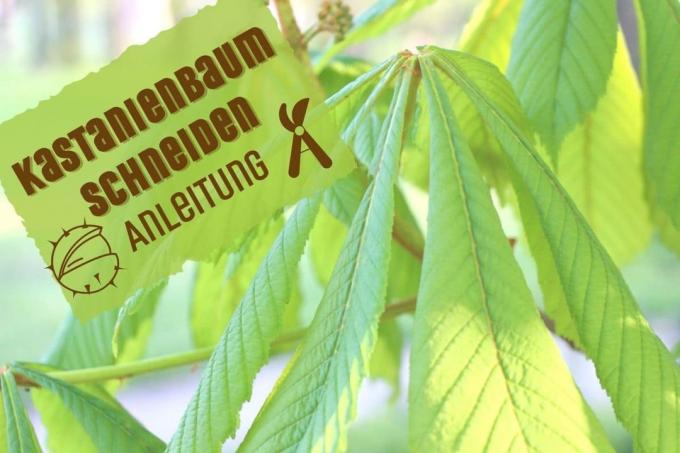
table of contents
- Chestnut and horse chestanines
- Cut the chestnut tree?
- Time for the cut
- tool
- Different cuts - instructions
- Care of the cuts
- frequently asked Questions
A chestnut tree does not need to be pruned. However, if you want to keep it small and shape it, you should consider the needs of the species when cutting. We have put together the most important facts for you.
In a nutshell
- Chestnuts are divided into sweet chestnuts with edible fruits and horse chestnuts with inedible fruits
- Tree pruning is not absolutely necessary
- Parenting cut recommended to develop a beautiful shape
- Be aware of the risk of fungal infections when cutting
- only use clean, sharp tools
Chestnut and horse chestanines
Chestnuts (Castanea) are a genus in the beech family (Fagaceae). In addition to the sweet chestnuts (C. sativa), the genus includes eleven other chestnut species.
Although the prickly fruits are similar, the horse chestnuts (Aesculus) are not classed as chestnuts. Horse chestnuts belong to the soap tree family (Sapindaceae).

Note: While chestnuts, the fruits of the sweet chestnuts, are considered a culinary specialty, the fruits of the horse chestnuts are inedible. Instead, they are ideal for making cute figures.
Chestnut as a garden tree
If you have a lot of space on the property, you can consider planting a chestnut tree. Mature trees reach heights of more than thirty meters. Many nurseries offer new varieties that are very decorative but remain small.
Cut the chestnut tree?
Experts do not agree on the necessity of pruning chestnuts. While some advise against pruning, others recommend regular pruning to stimulate growth and shape the tree as desired.
Note: Cut wounds on chestnuts close only slowly and thus serve as entry points for diseases and pests for longer. Nevertheless, if you pay attention to the sensitivity of the chestnut and take good care of the wounds, you can strengthen the resistance of the tree with a professional cut.
Time for the cut
- Cutting at the right time helps to minimize the risk of diseases / pests
- best time to cut chestnuts: between November and the end of February
- last cut by the end of March at the latest
- Outside temperatures below four degrees Celsius significantly reduce the susceptibility to cuts

Note: Young chestnut trees in particular can be strengthened by pruning them before the start of spring.
tool
Which tool is required for pruning the tree depends on the thickness of the branches.
- Branch diameter up to two centimeters: secateurs
- Up to five centimeters: loppers for two-handed operation
- over five centimeters: pruning saw
Attention: The cutting tools must be thoroughly cleaned and disinfected with alcohol before use. Use only sharp cutting tools to keep the risk of injury to a minimum.
Different cuts - instructions
Upbringing
In the first few years, chestnut trees benefit from a parenting pruning. The aim of this is to develop a strong trunk.
instructions
- Clean and disinfect tools.
- Select a thick shoot to later develop the trunk from.
- Cut off all other shoots vertically at the origin.
Thin out

The thinning enables the formation of new shoots and supports nice branching.
instructions
- Clean and disinfect cutting tools.
- Cut out dead and dry branches with scissors.
- Remove water shoots directly at the source, preferably tear out with a strong jerk.
Note: The shoots that go steeply upwards are called water shoots. They mainly educate themselves fruit-trees, but occasionally also occur on sweet chestnuts.
Form / crown cut
A chestnut tree with a well-formed crown becomes an eye-catcher on the property.
instructions
- Clean and disinfect cutting tools.
- Remove dead and diseased branches at the origin.
- Trim the crown all around, shortening the branches that have become too long.
Tip: Chestnut trees quickly reach a considerable height. Use a ladder and loppers with extendable telescopic arms for the shape cut.
Care of the cuts
Wound closures are offered in specialist shops. The guideline used to be that all cuts with a diameter of at least four centimeters must urgently be closed with a wound protection agent. Today, the focus is more on the natural resistance of the trees. We recommend cleaning the cut edges and only these with one Wound closure agents to spread.
Note: Large wounds on the chestnut tree heal well if they are wrapped in black foil for protection.
frequently asked Questions
Topiary is especially recommended for young trees up to the age of five. An annual clearing cut helps to keep the trees healthy at any age.
If you don't want to do without a chestnut in the garden, but have limited space, you should opt for the varieties 'Monstrosa' or 'Digitata'. A very decorative small chestnut variety is also the 'Laciniata'. It impresses with hanging branches and is only two to three meters high.
The sweet chestnut 'Marigoule' from France is perfect for the garden. It is between six and ten meters high. Its fruits are ripe early on. Those who plant this variety will be amazed by the beautiful flowers and the rich harvest!
